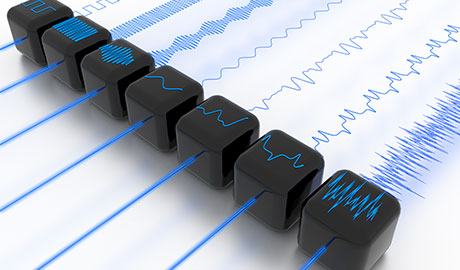 |
| Many end-users shell out the cash to acquire the newest high-end devices, plug in, and expect to be wowed |
A well-developed surveillance system can give a single security guard the power to see what otherwise might take a hundred pairs of eyes to see. But what happens when all the components are all connected and powered up, and the resulting image on the screen is, well, indiscernible, or, at the very least, terribly pixelated?
Many end-users shell out the cash to acquire the newest high-end devices, plug in, and expect to be wowed. Often enough, however, what they see on the screen is not what they were expecting – and they wonder what they just paid for. In a good high-definition system, what factors actually create the best image quality? With so many variables involved, from the camera’s lens to the imaging algorithms to the monitor resolution – just to name the obvious ones – how do system integrators achieve the best on-screen images?
The Lens
The first component to handle light from an object, this may be the one most taken for granted in cameras of any sort. (Just try scratching or cracking one and you’ll agree.) In the days of analog cameras, it seemed that any old lens would do just fine. However, as the technology inside cameras evolved and more powerful sensors (more pixels) became available, engineers and programmers demanded more from lenses. Moreover, intelligent video content analyses would be impossible without high-accuracy lenses.
In what way do lenses impact the image quality? The key factor here is light transmission. The quality of light passing through the lens itself will forever be critical to the quality of image reproduced. A lens made using ultra-precision molding aspherical technology achieves more accurate color, better light, and clearer images. Multilayer broadband anti-reflection coating further maximises a lens's light transmission while minimizing the residual reflection of light on the surface of each optical lens.
 |
| Variables involved include the camera’s lens, the imaging algorithms and the monitor resolution |
When it comes to fabricating a megapixel lens that hits the mark, the materials used and the processes by which lenses are produced are the two most critical criteria. The materials most often used to create lenses are glass and specialized plastics. An HD lens made of ultra-low-dispersion optical glass – which, by using dispersion characteristics that are different from those of conventional optical glass – will deliver better HD performance. Machine-automated lens production using specialized plastics results in high output for camera producers, and the lenses produced are more uniform in design and quality.
For an HD vari-focal lens, its image quality depends largely on the precision of the cam. The cam rotates to drive the zoom and focus lens groups forward and backward for a smooth continuity of focal length and adjustment of the focal point. A lack of precision with the cam inevitably causes an offset or tilt of the lens' optical axis during zooming and focusing, leading to a serious loss of image quality.
Lens production is a delicate |
Lens production is a delicate balancing act. The slightest errors or imperfections will be very noticeable when tested. The features of a lens that affect image resolution, clarity, and contrast must be perfect. Achieving uniformity of image resolution at the center and the edges of a lens requires high-precision machinery. And once a lens has been properly crafted, the assembly of the camera, the lens housing materials, and the alignment of the optical axis demand utmost accuracy. To put it mildly, quality control must be rigorous.
Image Signal Processing
As light passes through the lens, the sensor captures it and converts it to data. Raw RGB data is transmitted by the camera sensor and undergoes Image Signal Processing (ISP) such as noise reduction, white balance, WDR, curve correction and color correction, etc. The data is then transformed to true colors for each pixel point, for people to see images that look “normal” to the human eye. It is the Image Signal Processing that defines the final image quality on the screen.
Collecting data in different conditions is vital, for instance, outdoor data should be analyzed with natural light on days with sun, overcast, rain, and fog, at dawn, at dusk, and so on. Similarly, when using cameras equipped with infrared sensors, testing the IR light signals in various conditions is necessary as well.
Actual image performance depends upon variables such as low light illumination, signal to noise ratio, dynamic range of light, and more. ISP algorithms aim at increasing the signal data and decreasing noise. Cameras with Wide Dynamic Range (WDR) will yield improved video imaging with both background and foreground objects in high contrast or high-backlight environments, maximising the amount of detail in brighter and darker areas in one field-of-view. In scenes with low contrast and low light, the sensors deliver digital image signals and at the same time send some amount of digital noise that directly hinders image clarity. Three-dimensional digital noise reduction (3D DNR) removes unwanted artifacts from an image, reducing graininess. Where cloudy weather poses a challenge, auto-defogging technology helps to identify the density of fog or rain with gray-white color ratio analysis, and imbues images with true color reproduction.
 |
| Ramping up the megapixels and frame rates yields great video, but also results in more bandwidth used and more storage occupied |
Matching Megapixels To Image Quality
When the factors mentioned above line up well, correlating cameras and monitors creates the best viewing experience. When a high definition camera is in place, a monitor with a high resolution will display images much more clearly. But if the monitor’s resolution is low, it will not deliver the high-quality images expected – or possible – from that HD camera. For an 8 MP camera, for instance, users do best to apply monitors with 4K × 2K resolution. Though common sense, this deserves to be mentioned because users might decide to upgrade their systems with 4K monitors, but with perhaps 1.3 MP cameras installed. In such a scenario, there’s no guarantee the on-screen image quality will automatically improve.
Managing Data And Bandwidth
In terms of a complete, high definition surveillance system, when the right factors come together and the calibrations are set, image quality – even in a standard HD 1080p setup – can be extremely good. The final piece of the puzzle is managing the data. Ramping up the megapixels and frame rates yields great video, but also results in more bandwidth used and more storage occupied. Squeezing bandwidth threatens image quality and clarity, but keeping ample room for signal transmission and storage will eventually increase the overall cost for customers. Is it possible for integrators to optimize their customer’s system and, at the same time, stay within budget constraints? Luckily, it can be done.
Squeezing bandwidth threatens |
To do this, a more efficient video encoding solution would allow an improvement in compression efficiency of 40–50% over H.264. Improvements to algorithms that are adaptive to a particular scene give users control over bitrate. Another option would be to start recording video only when an event triggers an alarm, since most security guards are primarily concerned with moving objects rather than a scene’s generally stagnant background. This intelligently helps optimize bandwidth and storage consumption. Another method is to use a single panoramic or fisheye camera in place of several HD cameras for coverage – the reduced number of security devices will reduce bandwidth demands and the rate of storage consumption as well.
Getting The Best Image Quality
Now let’s put this all together. Naturally, integrators and users will refer to their product specs to understand features and functions, fine-tuning each component for best results. Also, as suggested above, users should select an HD camera comprehensively in terms of lens performance, pixels, image quality, and overall system compatibility and performance. Next, matching the backend device and management platform should be carefully considered in a complete security system. Installing equipment that has been engineered for a given scene is a must, along with strategising how to get the most coverage out of the lowest number of cameras. Finally, product quality, warranty, price, and on-going customer service are all important factors that customers should take into account as well.






















